radiator TOYOTA LAND CRUISER 2011 J200 Owners Manual
[x] Cancel search | Manufacturer: TOYOTA, Model Year: 2011, Model line: LAND CRUISER, Model: TOYOTA LAND CRUISER 2011 J200Pages: 608, PDF Size: 8.29 MB
Page 323 of 608
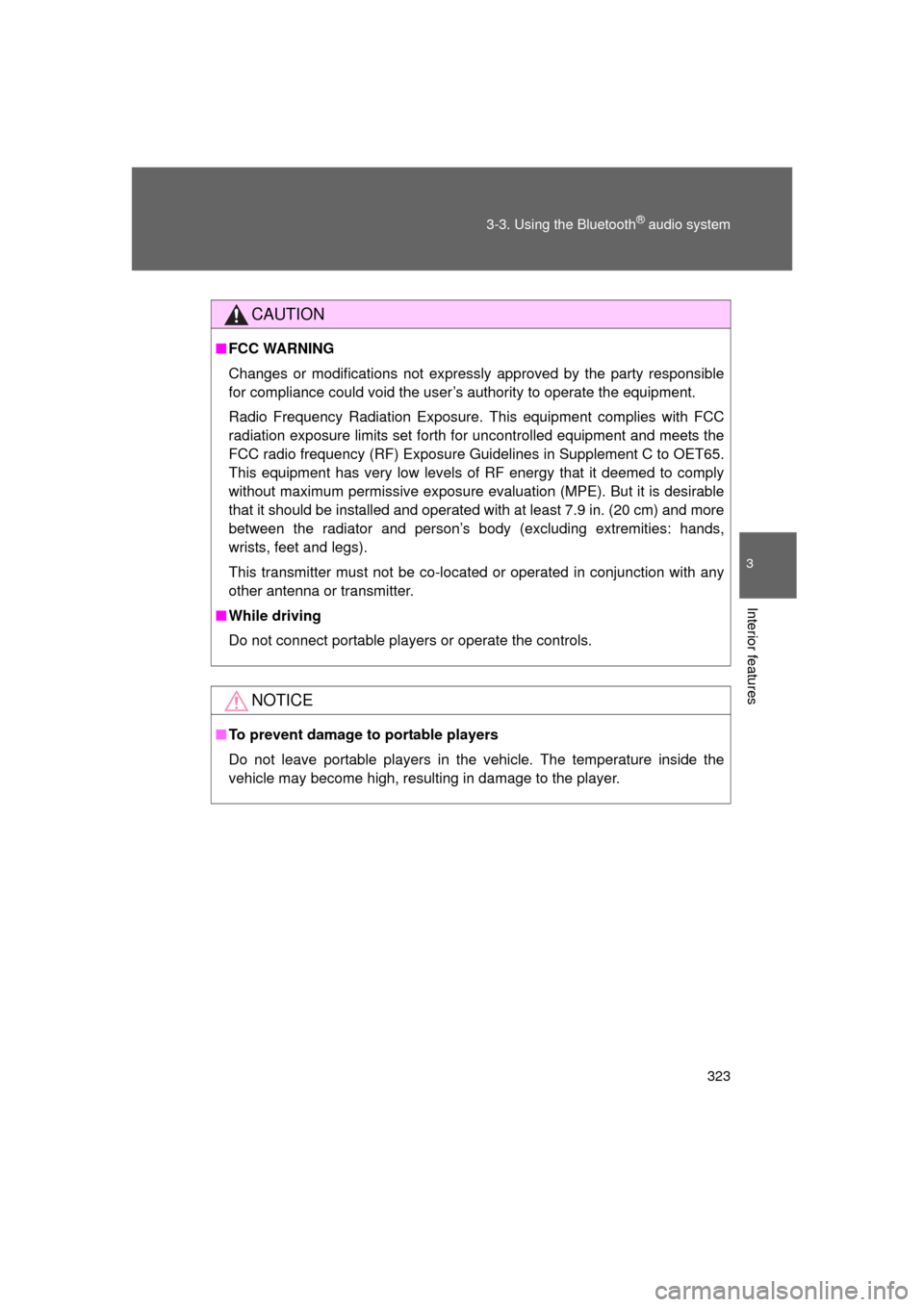
323
3-3. Using the Bluetooth
® audio system
3
Interior features
L/C200_U (OM60F74U)
CAUTION
■
FCC WARNING
Changes or modifications not expressly approved by the party responsible
for compliance could void the user’s authority to operate the equipment.
Radio Frequency Radiation Exposure. This equipment complies with FCC
radiation exposure limits set forth for uncontrolled equipment and meets the
FCC radio frequency (RF) Exposure Guidelines in Supplement C to OET65.
This equipment has very low levels of RF energy that it deemed to comply
without maximum permissive exposure evaluation (MPE). But it is desirable
that it should be installed and operated with at least 7.9 in. (20 cm) and more
between the radiator and person’s body (excluding extremities: hands,
wrists, feet and legs).
This transmitter must not be co-located or operated in conjunction with any
other antenna or transmitter.
■ While driving
Do not connect portable players or operate the controls.
NOTICE
■To prevent damage to portable players
Do not leave portable players in the vehicle. The temperature inside the
vehicle may become high, resulting in damage to the player.
Page 344 of 608
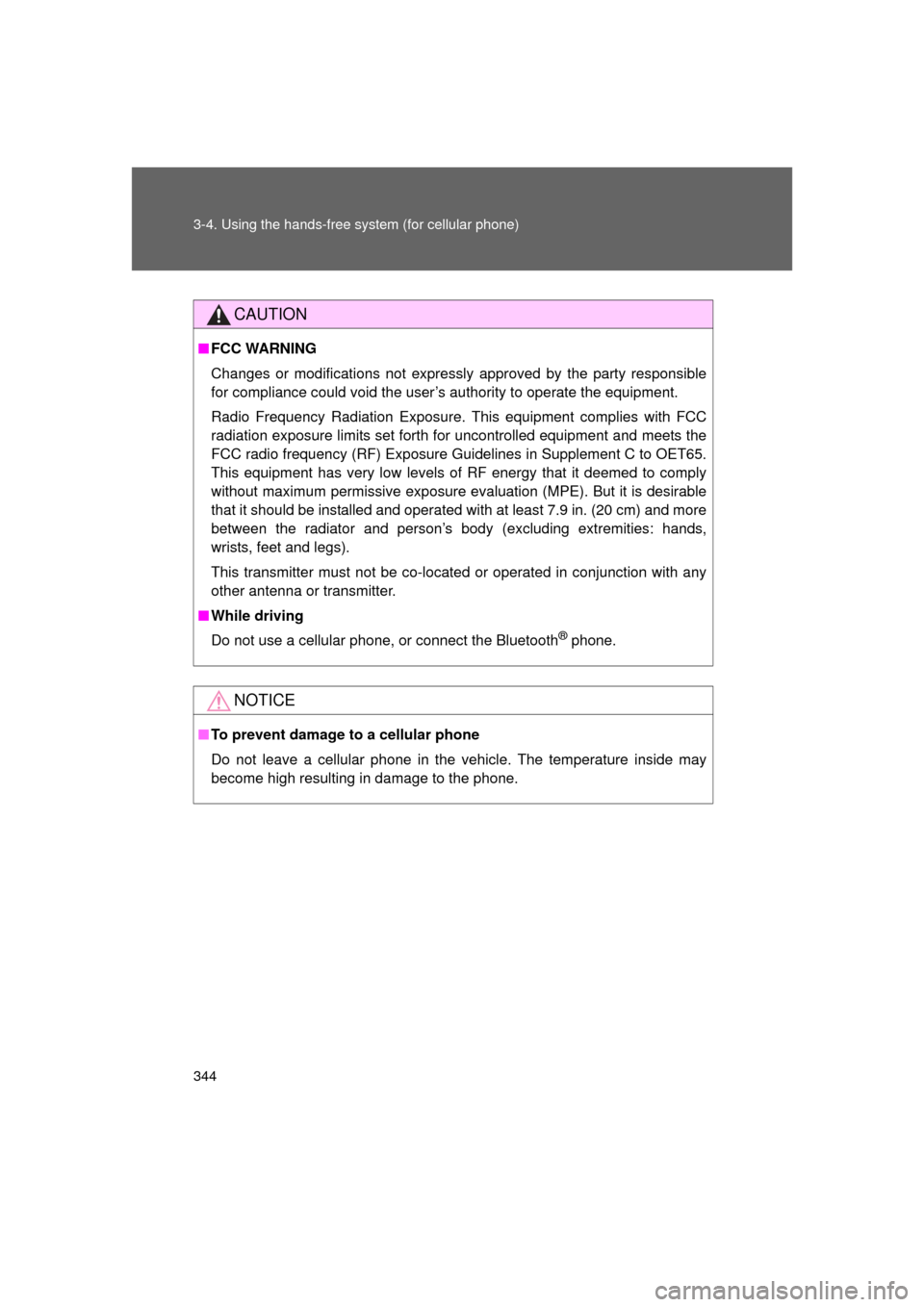
344 3-4. Using the hands-free system (for cellular phone)
L/C200_U (OM60F74U)
CAUTION
■FCC WARNING
Changes or modifications not expressly approved by the party responsible
for compliance could void the user’s authority to operate the equipment.
Radio Frequency Radiation Exposure. This equipment complies with FCC
radiation exposure limits set forth for uncontrolled equipment and meets the
FCC radio frequency (RF) Exposure Gui delines in Supplement C to OET65.
This equipment has very low levels of RF energy that it deemed to comply
without maximum permissive exposure evaluation (MPE). But it is desirable
that it should be installed and operated with at least 7.9 in. (20 cm) and more
between the radiator and person’s body (excluding extremities: hands,
wrists, feet and legs).
This transmitter must not be co-located or operated in conjunction with any
other antenna or transmitter.
■ While driving
Do not use a cellular phone, or connect the Bluetooth
® phone.
NOTICE
■To prevent damage to a cellular phone
Do not leave a cellular phone in the vehicle. The temperature inside may
become high resulting in damage to the phone.
Page 432 of 608
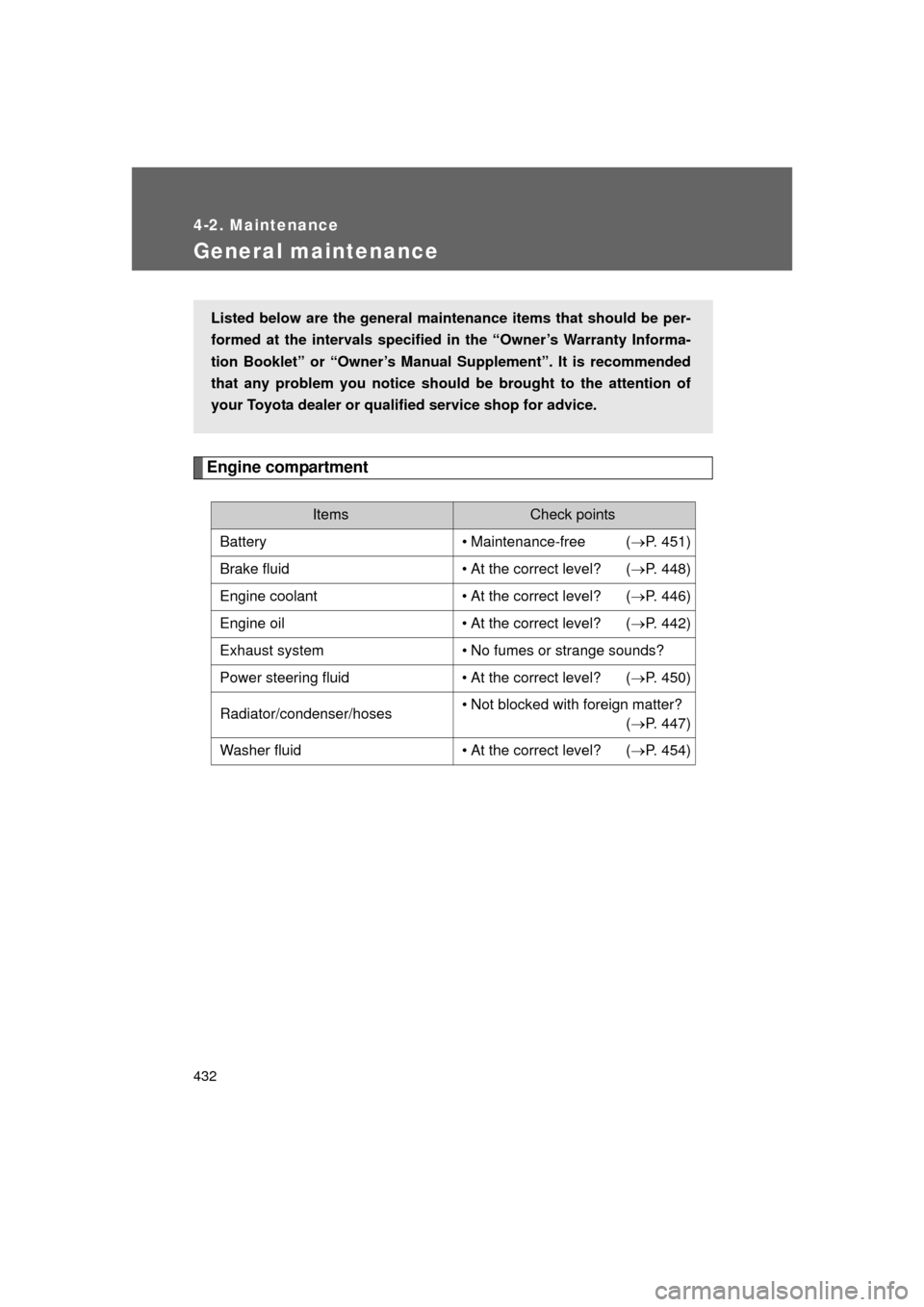
432
4-2. Maintenance
L/C200_U (OM60F74U)
General maintenance
Engine compartment
ItemsCheck points
Battery • Maintenance-free ( P. 451)
Brake fluid • At the correct level? ( P. 448)
Engine coolant • At the correct level? ( P. 446)
Engine oil • At the correct level? ( P. 442)
Exhaust system • No fumes or strange sounds?
Power steering fluid • At the correct level? ( P. 450)
Radiator/condenser/hoses • Not blocked with foreign matter?
(P. 447)
Washer fluid • At the correct level? ( P. 454)
Listed below are the general maintenance items that should be per-
formed at the intervals specified in the “Owner’s Warranty Informa-
tion Booklet” or “Owner’s Manual Supplement”. It is recommended
that any problem you notice should be brought to the attention of
your Toyota dealer or qualified service shop for advice.
Page 437 of 608
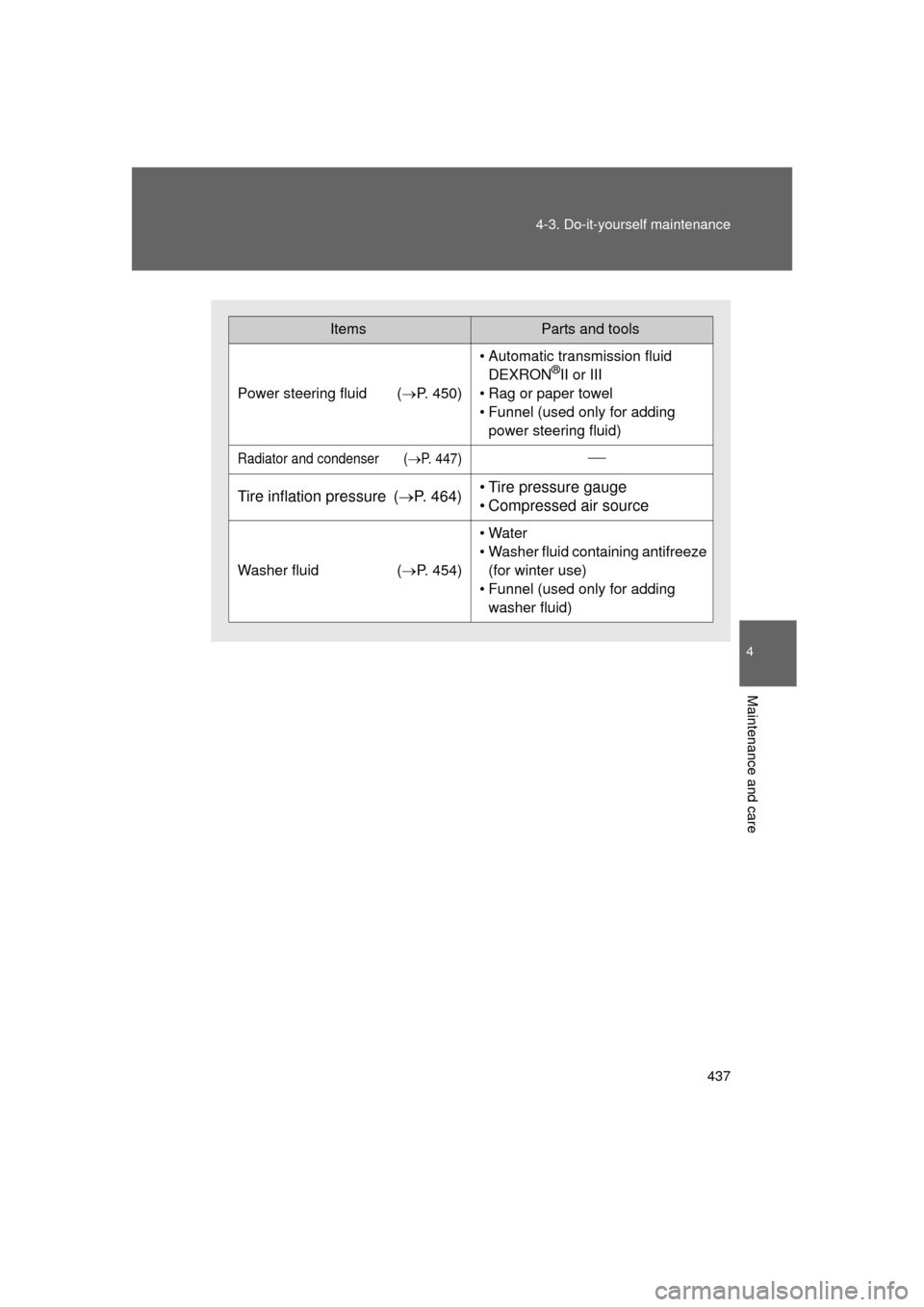
437
4-3. Do-it-yourself maintenance
4
Maintenance and care
L/C200_U (OM60F74U)
ItemsParts and tools
Power steering fluid (
P. 450)
• Automatic transmission fluid
DEXRON®II or III
• Rag or paper towel
• Funnel (used only for adding power steering fluid)
Radiator and condenser (P. 447)
Tire inflation pressure ( P. 464)• Tire pressure gauge
• Compressed air source
Washer fluid (P. 454)
• Water
• Washer fluid containing antifreeze
(for winter use)
• Funnel (used only for adding washer fluid)
Page 438 of 608
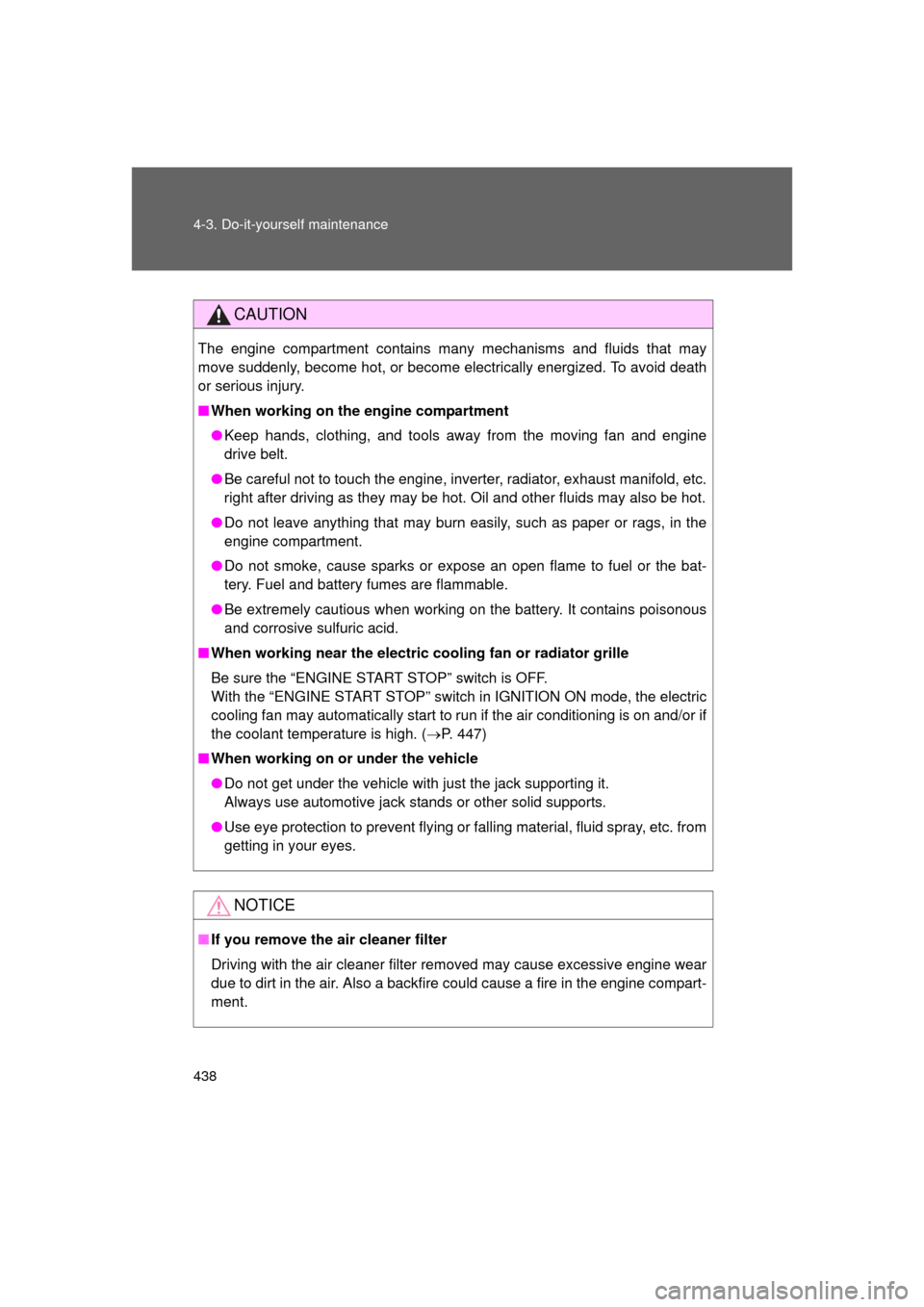
438 4-3. Do-it-yourself maintenance
L/C200_U (OM60F74U)
CAUTION
The engine compartment contains many mechanisms and fluids that may
move suddenly, become hot, or become electrically energized. To avoid death
or serious injury.
■When working on the engine compartment
● Keep hands, clothing, and tools away from the moving fan and engine
drive belt.
● Be careful not to touch the engine, inverter, radiator, exhaust manifold, etc.
right after driving as they may be hot. Oil and other fluids may also be hot.
● Do not leave anything that may burn easily, such as paper or rags, in the
engine compartment.
● Do not smoke, cause sparks or expose an open flame to fuel or the bat-
tery. Fuel and battery fumes are flammable.
● Be extremely cautious when working on the battery. It contains poisonous
and corrosive sulfuric acid.
■ When working near the electric cooling fan or radiator grille
Be sure the “ENGINE START STOP” switch is OFF.
With the “ENGINE START STOP” switch in IGNITION ON mode, the electric
cooling fan may automatically start to run if the air conditioning is on and/or if
the coolant temperature is high. ( P. 447)
■ When working on or under the vehicle
● Do not get under the vehicle with just the jack supporting it.
Always use automotive jack stands or other solid supports.
● Use eye protection to prevent flying or falling material, fluid spray, etc. from
getting in your eyes.
NOTICE
■If you remove the air cleaner filter
Driving with the air cleaner filter removed may cause excessive engine wear
due to dirt in the air. Also a backfire could cause a fire in the engine compart-
ment.
Page 440 of 608
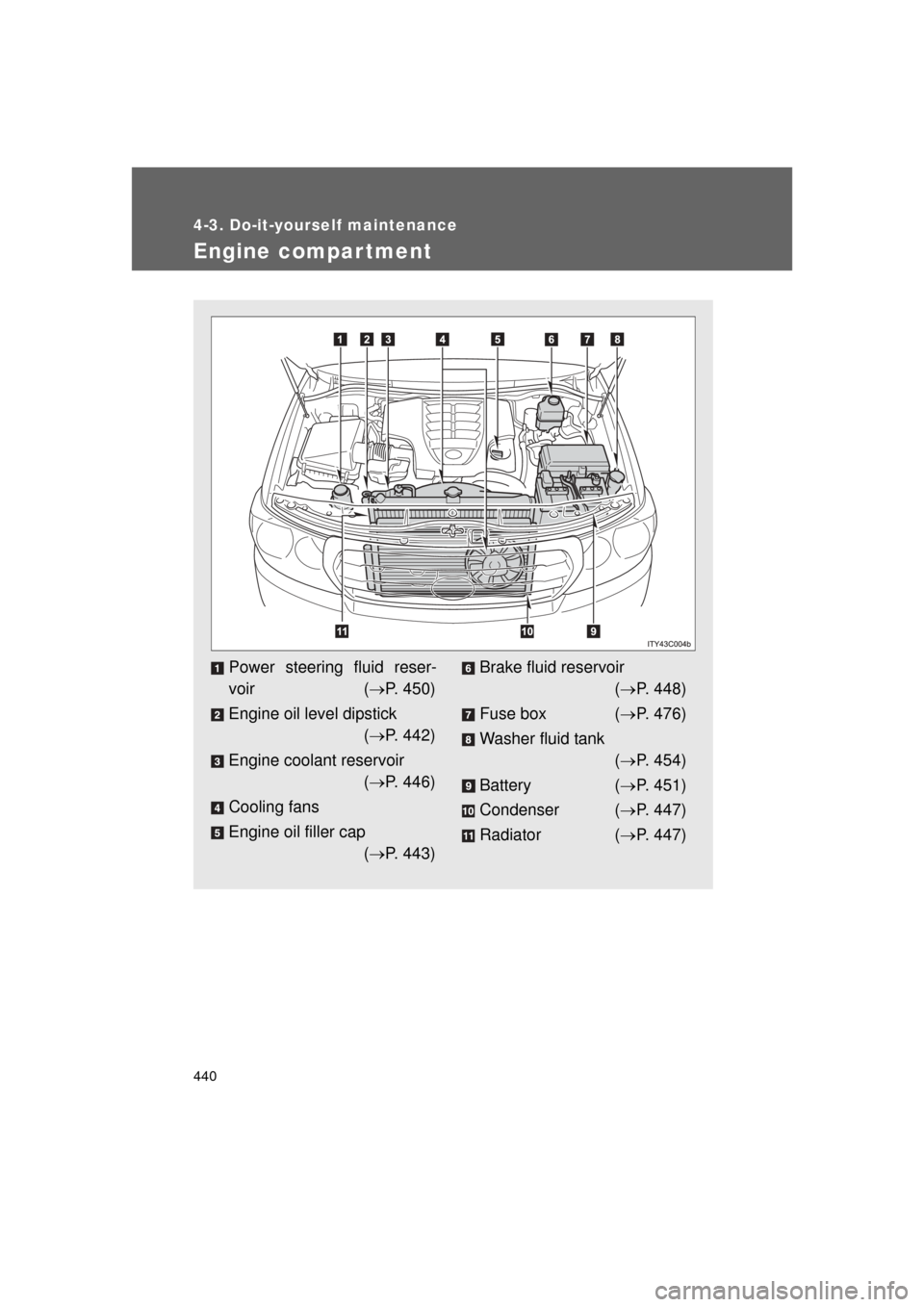
440
4-3. Do-it-yourself maintenance
L/C200_U (OM60F74U)
Engine compar tment
Power steering fluid reser-
voir (P. 450)
Engine oil level dipstick ( P. 442)
Engine coolant reservoir ( P. 446)
Cooling fans
Engine oil filler cap ( P. 443)Brake fluid reservoir
( P. 448)
Fuse box ( P. 476)
Washer fluid tank ( P. 454)
Battery ( P. 451)
Condenser ( P. 447)
Radiator ( P. 447)
Page 446 of 608
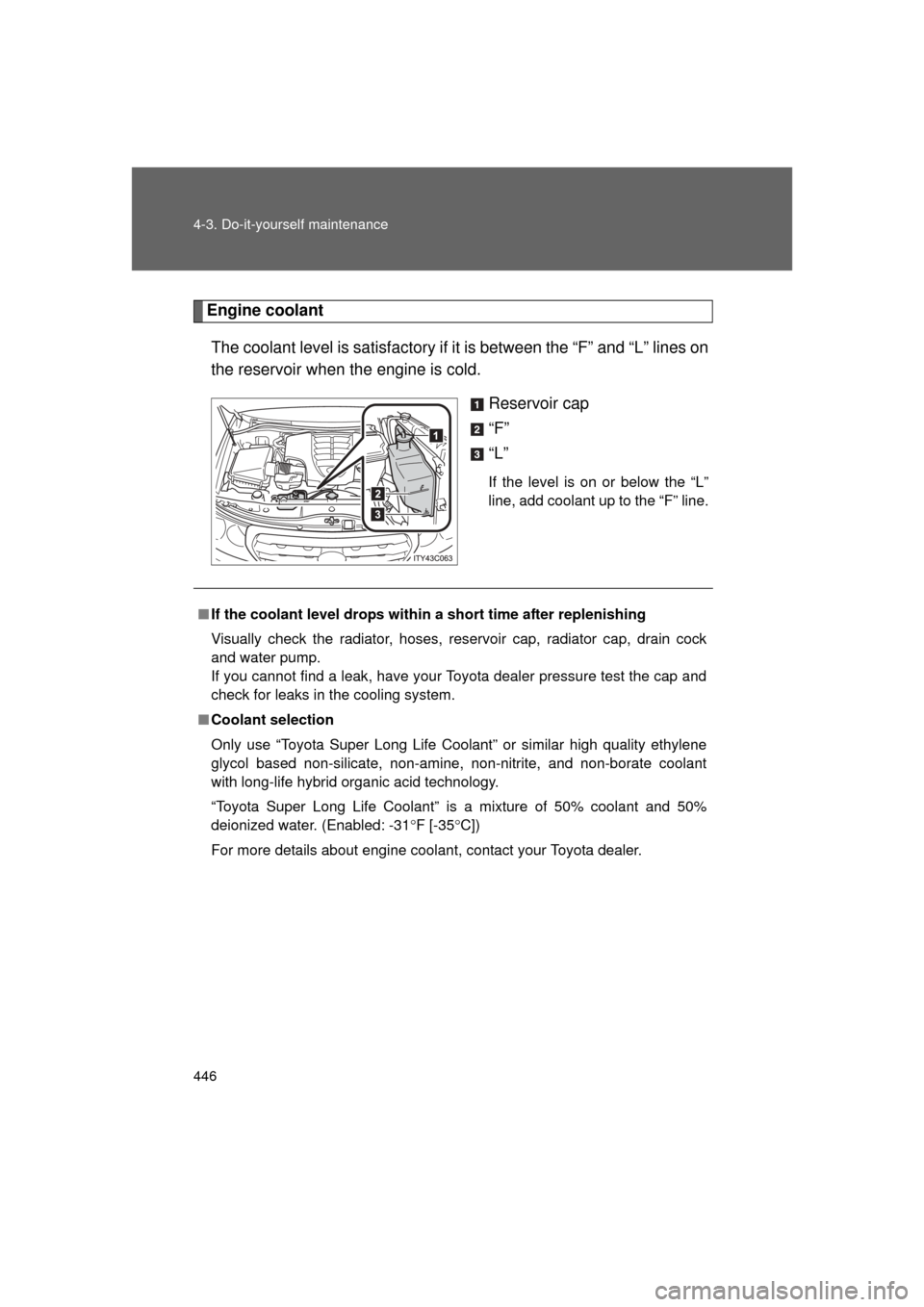
446 4-3. Do-it-yourself maintenance
L/C200_U (OM60F74U)
Engine coolantThe coolant level is sati sfactory if it is between the “F” and “L” lines on
the reservoir when the engine is cold.
Reservoir cap
“F”
“L”
If the level is on or below the “L”
line, add coolant up to the “F” line.
■If the coolant level drops within a short time after replenishing
Visually check the radiator, hoses, reservoir cap, radiator cap, drain cock
and water pump.
If you cannot find a leak, have your Toyota dealer pressure test the cap and
check for leaks in the cooling system.
■ Coolant selection
Only use “Toyota Super Long Life Coolant” or similar high quality ethylene
glycol based non-silicate, non-amine, non-nitrite, and non-borate coolant
with long-life hybrid organic acid technology.
“Toyota Super Long Life Coolant” is a mixture of 50% coolant and 50%
deionized water. (Enabled: -31 F [-35 C])
For more details about engine coolant, contact your Toyota dealer.
Page 447 of 608
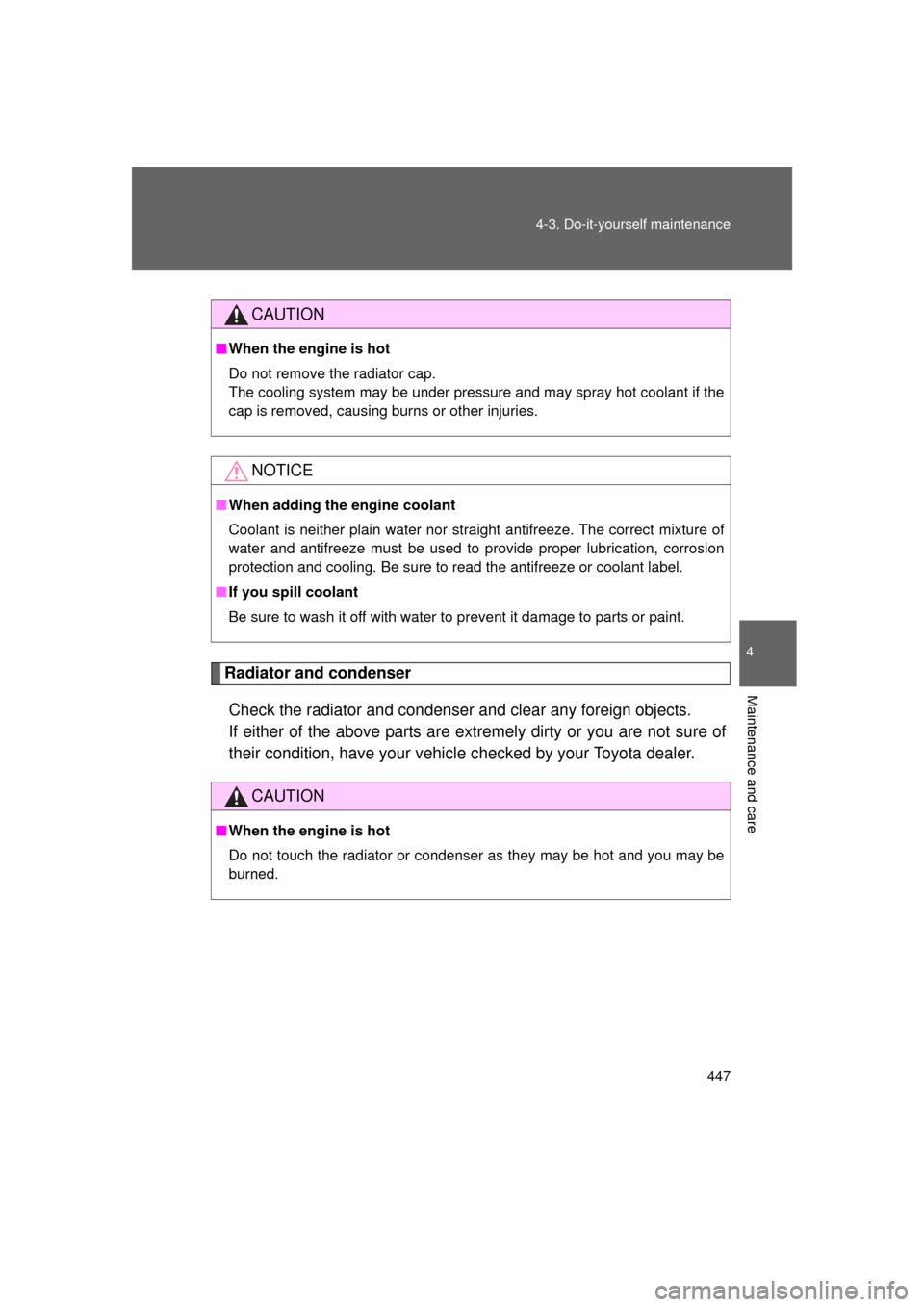
447
4-3. Do-it-yourself maintenance
4
Maintenance and care
L/C200_U (OM60F74U)
Radiator and condenser
Check the radiator and condenser and clear any foreign objects.
If either of the above parts are extremely dirty or you are not sure of
their condition, have your vehicl e checked by your Toyota dealer.
CAUTION
■When the engine is hot
Do not remove the radiator cap.
The cooling system may be under pressure and may spray hot coolant if the
cap is removed, causing burns or other injuries.
NOTICE
■When adding the engine coolant
Coolant is neither plain water nor stra ight antifreeze. The correct mixture of
water and antifreeze must be used to provide proper lubrication, corrosion
protection and cooling. Be sure to read the antifreeze or coolant label.
■ If you spill coolant
Be sure to wash it off with water to prevent it damage to parts or paint.
CAUTION
■When the engine is hot
Do not touch the radiator or condenser as they may be hot and you may be
burned.
Page 551 of 608
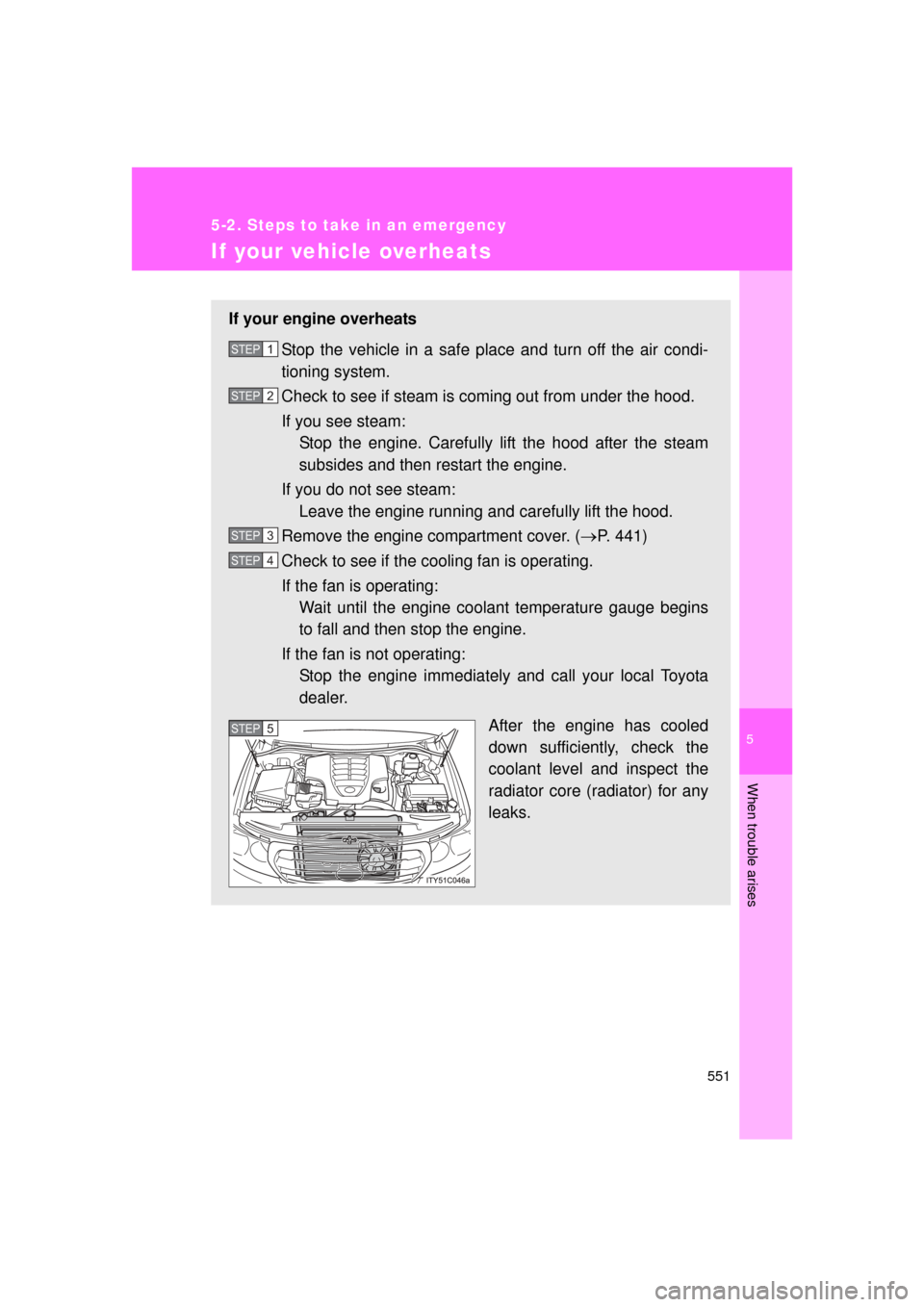
5
When trouble arises
551
5-2. Steps to take in an emergency
L/C200_U (OM60F74U)
If your vehicle overheats
If your engine overheatsStop the vehicle in a safe place and turn off the air condi-
tioning system.
Check to see if steam is coming out from under the hood.
If you see steam: Stop the engine. Carefully lift the hood after the steam
subsides and then restart the engine.
If you do not see steam: Leave the engine running and carefully lift the hood.
Remove the engine compartment cover. (
P. 441)
Check to see if the cooling fan is operating.
If the fan is operating: Wait until the engine coolant temperature gauge begins
to fall and then stop the engine.
If the fan is not operating: Stop the engine immediately and call your local Toyota
dealer.
After the engine has cooled
down sufficiently, check the
coolant level and inspect the
radiator core (radiator) for any
leaks.
STEP1
STEP2
STEP3
STEP4
STEP5
Page 552 of 608
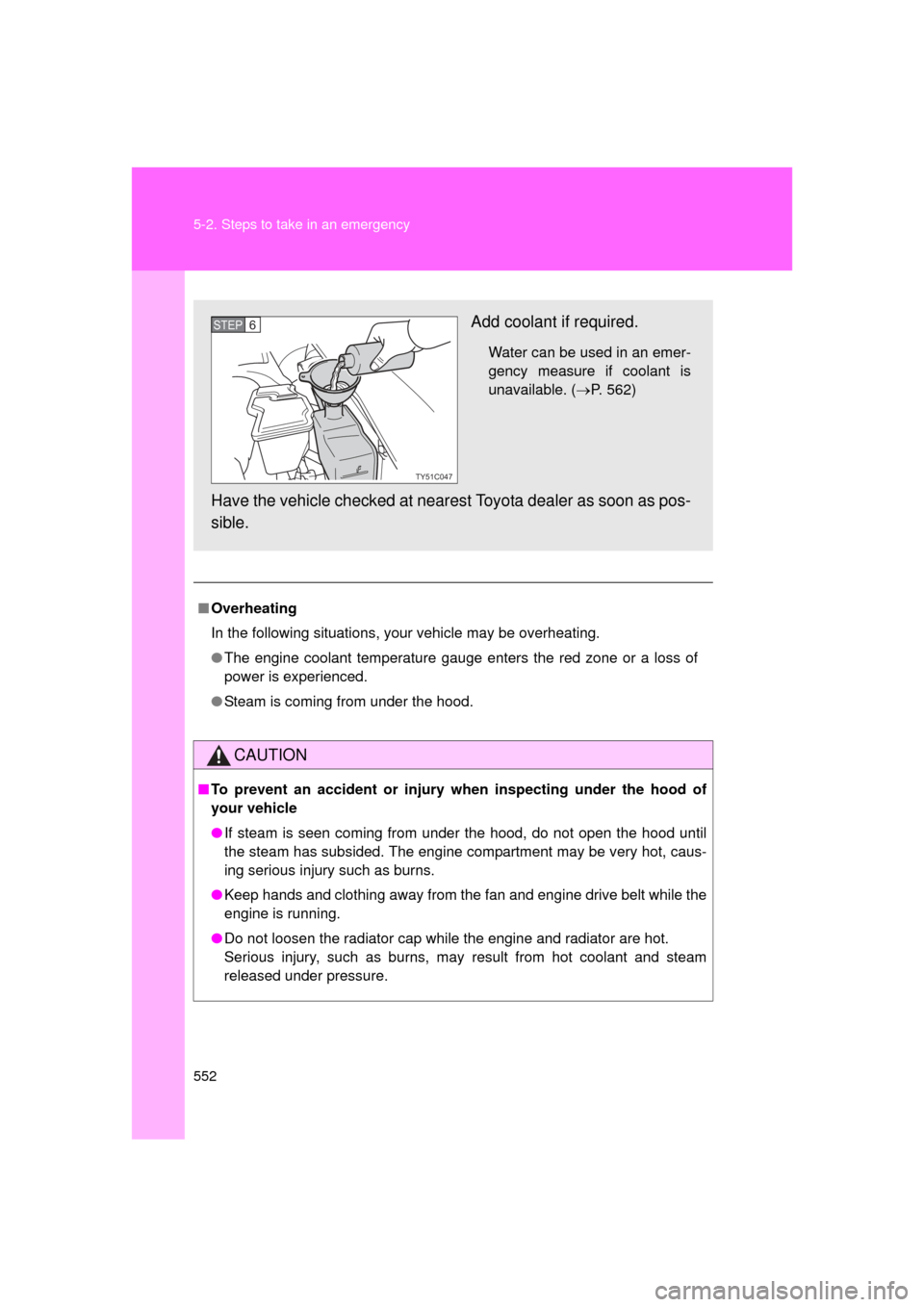
552 5-2. Steps to take in an emergency
L/C200_U (OM60F74U)
■Overheating
In the following situations, your vehicle may be overheating.
● The engine coolant temperature gauge enters the red zone or a loss of
power is experienced.
● Steam is coming from under the hood.
CAUTION
■To prevent an accident or injury when inspecting under the hood of
your vehicle
● If steam is seen coming from under the hood, do not open the hood until
the steam has subsided. The engine compartment may be very hot, caus-
ing serious injury such as burns.
● Keep hands and clothing away from the fan and engine drive belt while the
engine is running.
● Do not loosen the radiator cap while the engine and radiator are hot.
Serious injury, such as burns, may result from hot coolant and steam
released under pressure.
Add coolant if required.
Water can be used in an emer-
gency measure if coolant is
unavailable. ( P. 562)
Have the vehicle checked at neares t Toyota dealer as soon as pos-
sible.
TY51C047
STEP6